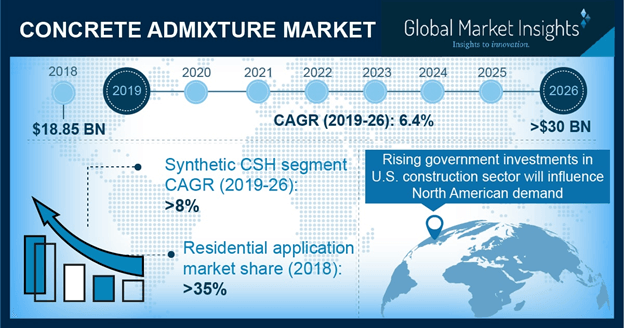APAC concrete admixture market to attain substantial proceeds by 2024, growing demand for sustainable construction products to fuel the industry growth
Publisher : Fractovia | Published Date : 2018-03-28Request Sample
The exponential growth that concrete admixture market has witnessed lately can be aptly credited to not only the soaring global construction industry but also the concerns about water consumption. The construction industry has long since debated regarding the issue of water consumption – a problem which has been fractionally resolved by the use of concrete admixtures. Using this product is not only beneficial in terms of strengthening and waterproofing concrete, but also because it replaces the use of large volumes of water which had been a rather irreplaceable part of construction prior to the use of concrete admixtures.
U.S. Concrete Admixture Market Size, By Application, 2013 – 2024 (USD Billion)

The issue has become even more intense post the Business Council for Sustainable Development’s launch of the Cement Sustainability Initiative in 2014 to track the use, recycling or discarding of water in the construction industry. Indeed, CSI was a major initiative in raising awareness about addressing the staggering consumption of water in the construction industry and opened a growth avenue for the use of modern technology in lowering water usage. In consequence, this has had a commendable impact on concrete admixture industry size, pegged at USD 18 billion in 2016.
As per authentic estimates, over 30 billion tons of Portland cement-based concrete were produced in 2011. Ideally, the water to cement ratio in a typical concrete preparation can vary between 0.35 to 0.40 ton of water for each ton of cement. This leads to the estimation that 1.3 to 1.5 billion tons of water is annually consumed during the chemical production of concrete. Curing of concrete may require up to 28 days and during this time, more water is added to the concrete to offset water loss through evaporation. This further adds to the water consumption of ordinary Portland cement and the annual estimate of water consumption ends up between 2.15 to 2.6 trillion liters. These figures provide a clear evidence of why the current situation desperately demands the use of concrete admixtures. Undeniably, the increased use of the product can drastically reduce the water scarcity problem the construction industry faces as of today.
Analyzing that the construction sector has been expanding at an unprecedented pace, it is rather overt that concrete admixtures industry will register a massive growth rate in the ensuing years, considering the problems of water scarcity. Water reducing concrete admixtures not only result in creating desired slump in a lower water-cement ration but also obtain specific strength using lower cement content. Lower cement content further leads to lower CO2 emission which is one of the leading factors responsible for the increasing demand of superplasticizers in the construction industry across the globe. Indeed, estimates claim that such plasticizers and superplasticizers can reduce the water requirement by 15% to 30% and are majorly applicable in producing heavy reinforced structures with inaccessible areas. In this regard, it is prudent to mention that superplasticizer based concrete admixture industry is estimated to exhibit a robust CAGR of 9.5% over 2017-2024.
The chief disadvantage of superplasticizers is slump loss due to long transportation time, hot weather and reactive cements. But this drawback has been overcome by improved polycarboxylate based superplasticizers which not only enhance the slump level but also contribute in 40% water reduction in concrete formulation, further expanding the scope of concrete admixture market.
Speaking from a regional perspective, it is noteworthy to state that the construction industry has registered the most commendable growth across the Asia Pacific turf, owing to the population explosion in India and China. The emerging middle-class populace has further stimulated the demand for massive residential construction, making APAC one of the most viable regions for concrete admixture market. Indeed, Asia Pacific accounted for 40% of the overall concrete admixture market share in 2016 and is expected to hold a commendable proportion of the revenue by 2024. Significant investments in new construction projects have also been made across Southeast Asian regions such as Indonesia and Malaysia. Inevitably, the construction industry has been expanding across most of the APAC geographies, adding to the growth of concrete admixture market across this continent.
While regular admixtures possess exceptional water reducing capabilities, it is important to note that different types of concrete admixtures can attribute different favorable qualities to concrete. This ranges from waterproofing to air entrainment to shrinkage reduction – a range of beneficial characteristics that has helped expand the scope of concrete admixture industry. Due to the sheer size of the construction industry, the use of sustainable technology and materials is also being enforced by regulatory bodies to save the planet from increased greenhouse gases and water scarcity. Concrete admixture market thus, is coming to play an increasingly important role in enhancing the sustainable concrete industry. By 2024, analysts predict concrete admixture market size to surpass a whopping $38 billion.